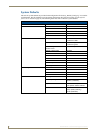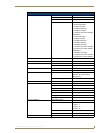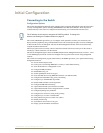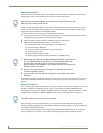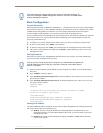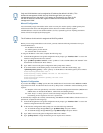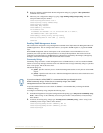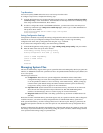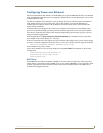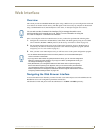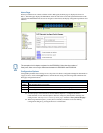
Initial Configuration
16
NXA-ENET24 - Software Management Guide
Trap Receivers
You can also specify SNMP stations that are to receive traps from the switch.
To configure a trap receiver, complete the following steps:
1. From the Privileged Exec level global configuration mode prompt, type “snmp-server host host-address
community-string”, where “host-address” is the IP address for the trap receiver and “community-string”
is the string associated with that host. Press <Enter>.
2. In order to configure the switch to send SNMP notifications, you must enter at least one snmp-server
enable traps command. Type “snmp-server enable traps type”, where “type” is either authentication or
link-up-down. Press <Enter>.
Console(config)#snmp-server enable traps link-up-down
Console(config)#
Saving Configuration Settings
Configuration commands only modify the running configuration file and are not saved when the switch is
rebooted. To save all your configuration changes in nonvolatile storage, you must copy the running
configuration file to the start-up configuration file using the “copy” command.
To save the current configuration settings, enter the following command:
1. From the Privileged Exec mode prompt, type “copy running-config startup-config” and press <Enter>.
2. Enter the name of the start-up file. Press <Enter>.
Console#copy running-config startup-config
Startup configuration file name []: startup
\Write to FLASH Programming.
\Write to FLASH finish.
Success.
Console#
Managing System Files
The switch’s flash memory supports three types of system files that can be managed by the CLI program, Web
interface, or SNMP. The switch’s file system allows files to be uploaded and downloaded, copied, deleted, and
set as a start-up file.
The three types of files are:
Configuration: These files store system configuration information and are created when
configuration settings are saved. Saved configuration files can be selected as a system start-up file
or can be uploaded via TFTP to a server for backup. A file named “Factory_Default_Config.cfg”
contains all the system default settings and cannot be deleted from the system. See the Saving
Configuration Settings section on page 16 for more information.
Operation Code: System software that is executed after boot-up, also known as run-time code.
This code runs the switch operations and provides the CLI, Web and SNMP management
interfaces. See the Managing Firmware section on page 31 for more information.
Diagnostic Code: Software that is run during system boot-up, also known as POST (Power On
Self-Test).
Due to the size limit of the flash memory, the switch supports only two operation code files, and two diagnostic
code files. However, you can have as many configuration files as available flash memory space allows.
In the system flash memory, one file of each type must be set as the start-up file. During a system boot, the
diagnostic and operation code files set as the start-up file are run, and then the start-up configuration file is
loaded.
Note that configuration files should be downloaded using a file name that reflects the contents or usage of the
file settings. If you download directly to the running-config, the system will reboot, and the settings will have
to be copied from the running-config to a permanent file.



